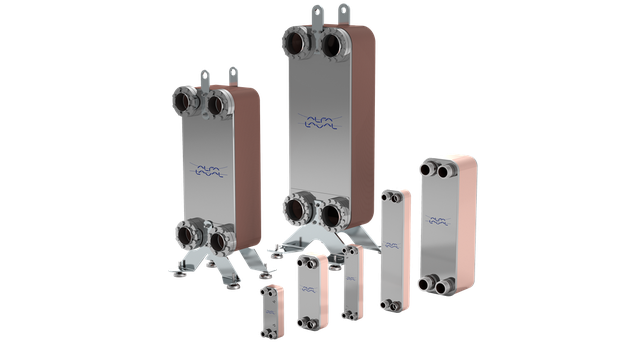CB
The Alfa Laval CB range of brazed plate heat exchangers feature efficient heat transfer with an extremely small footprint, making them ideal for demanding installations where space is at a premium. The CB range is used in HVAC heating/cooling, refrigeration, process heating/cooling, oil cooling, solar heating and many other applications.
The thin, corrugated stainless steel plates used in the CB design are brazed together with copper. This forms a self-contained unit that can handle both high pressures and high temperatures. And unlike traditional designs, the brazed plate heat exchanger consists solely of surfaces that actively contribute to heat transfer, resulting in significant increases in overall efficiency.
The CB range of brazed plate heat exchangers has numerous advantages over traditional heat exchangers in both industrial, HVAC and refrigeration installations. The exceptional heat transfer efficiency makes all CB units very compact. As a result, they can tackle large-capacity duties even though there is only limited installation space available.
The brazed construction also does away with gaskets, making CB units ideal in applications where temperatures and/or pressures are high. Examples include district heating and a wide range of heating, cooling and tap water solutions.
Alfa Laval is the world's leading manufacturer of brazed plate heat exchangers. This means solid experience in designing units that withstand high-pressure and high-temperature conditions, and in coping effectively with the structural stresses that results from these. Units in the CB range are available in many different sizes and capacities, with varying plate patterns and connections for particular duties and performance specifications. CB units can be configured as single-pass, dual-pass or multi-pass installations, according to project requirements.
All CB brazed heat exchanger units comply with the European Pressure Vessel Safety Directive, and can also be delivered according to other relevant standards and national codes, as required.
Fonctionnement
Dans les échangeurs de chaleur à plaques brasées en cuivre, les surfaces utilisées pour fournir l’échange thermique d’un fluide à l’autre sont des plaques corruguées fines en acier inoxydable qui sont empilées les unes au-dessus des autres. Une brasure cuivre réalisée sur le contour des plaques maintient les deux fluides à l'intérieur du paquet de plaques. Contrairement aux modèles traditionnels, l’échangeur de chaleur à plaques brasées ainsi produit est uniquement composé de surfaces qui contribuent activement au transfert de chaleur, ce qui entraîne des augmentations significatives du rendement global.
Les canaux formés entre les plaques et les piquages sont disposés de façon à ce que les fluides s'écoulent par les canaux alternativement, toujours à contre-courant, pour obtenir l'échange de chaleur le plus efficace.
Les points de contact entre les plaques sont également brasés afin de supporter les hautes pressions et des températures élevées. Les pics de pression et les variations rapides de température provoquent des contraintes physiques considérables sur les matériaux et la recherche Alfa Laval s’est concentrée sur les détails de ces phénomènes, afin de s’assurer que les modèles sont extrêmement résistants et offrent une longue durée de vie.

